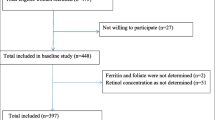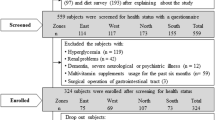Abstract
Deficiencies of micronutrients (zinc, iron, folic acid and iodine) during pregnancy are known causes of Low Birth Weight (LBW). Studies have documented status of one or two micronutrients amongst pregnant women (PW). However, no attempt has been made to concurrently assess the prevalence of multiple micronutrient deficiencies and the factors associated with them amongst PW.Objective: The present study was undertaken to assess the prevalence of multiple micronutrient deficiencies amongst PW in a rural area.Methods: A community based cross sectional survey was conducted in six villages of a rural area of district Faridabad in Haryana state, India during November 2000 and October 2001. All PW aged 18 years or more, with pregnancy duration of more than 28 weeks were enrolled. Data were collected on socio-economic status and other demographic parameters. Serum zinc, copper and magnesium levels were estimated by utilizing the Atomic absorption spectrophotometry (AAS); serum ferritin and folate was estimated by Enzyme Linked Immuno Sorbent Assay (ELISA) method and the Radio-lmmuno Assay (RIA) method, respectively and serum thyroid stimulating hormone (TSH) level was estimated by the Abbot AxSYM System. Serum zinc, copper, magnesium, ferritin, and folate levels less than 70.0 μg/dl, 80.0 μg/dl, 1.80 mg/dl, 15 ng/ml, and 3 ng/ml, respectively were considered as indicative of deficiency for respective micronutrients. The TSH levels of 4.670 and more indicated iodine deficiency status. Dietary intake of micronutrients was assessed utilizing 1-day 24-hour dietary recall methodology. Food consumption pattern was assessed utilizing the food frequency questionnaire methodology.Results: Nearly 73.5, 2.7, 43.6, 73.4, 26.3, and 6.4 percent PW were deficient in zinc, copper, magnesium, iron, folic acid and iodine, respectively. The highest concurrent prevalence of two, three, four and five micronutrient deficiency was of zinc and iron (54.9%); zinc, magnesium and iron (25.6%); zinc, magnesium, iron and folic acid (9.3%) and zinc, magnesium, iron, folic acid and iodine (0.8%), respectively. No pregnant woman was found to have concomitant deficiencies of all the six micronutrients. Dietary intake data revealed an inadequate nutrient intake. Over 19% PW were consuming less than 50% of the recommended calories. Similarly, 99, 86.2, 75.4, 23.6, 3.9 percent of the PW were consuming less than 50% of the recommended folic acid, zinc, iron, copper, and magnesium. The consumption of food groups rich in micronutrients (pulses, vegetables, fruits, nuts and oil seeds, animal foods) was infrequent. Univariate and Multivariate logistic regression analysis revealed that low dietary intake of nutrients, low frequency of consumption of food groups rich in micronutrients and increased reproductive cycles with short interpregnancy intervals were important factors leading to micronutrient deficiencies.Conclusion: There was a high prevalence of micronutrient deficiencies amongst the PW of the area, possibly due to the poor dietary intake of food and low frequency of consumption of food groups rich in micronutrients. The concurrent prevalence of two, three, four and five micronutrient deficiencies were common.
Similar content being viewed by others
References
King JC. Determination of maternal zinc status during pregnancy.Am J Clin Nutr 2000; 71: 1334S-1343S.
Yasodhara P, Ramaraju LA, Raman L: Trace minerals in pregnancy 1. Copper and Zinc.Nutr Res 1996; 11: 15–21.
Kumar SP. Zinc deficiency in neonates.Indian J Pediatr 1987; 54: 465–466.
Prasad LSN, Ganguly S, Vasuki K. Role of zinc in fetal nutrition.Indian Pediatr 1974; 11: 799–802
Caulfield LE, Zavaleta N, Shanker AH, Merialdi M. Potential contribution of maternal zinc supplementation during pregnancy to maternal and child survival.Am J Clin Nutr 1998; 68: 499S-508S.
Fawcett WJ, Haxby EJ, Male DA. Magnesium: physiology and pharmacology.Br J Anaesth 1999; 83: 302–320
Almonte RA, Heath DL, Whitehall J, Russell MJ, Patole S, Vink R. Gestational magnesium deficiency is deleterious to fetal outcome.Biol Neonate 1999; 76: 26–32.
Wynn A, Wynn M. Magnesium and other nutrient deficiencies as possible causes of hypertension and low birth weight.Nutr Health 1988; 6: 69–88.
Thimmayamma BVS. A handbook of schedules and guidelines in socio-economic and diet surveys Hyderabad National Institute of Nutrition — Indian Council of Medical Research Press, 1987
Gopalan C, Ramashastri BV, Balasubramanian SC. Nutritive Value of Indian Foods, Hyderabad, National Institute of Nutrition — Indian Council of Medical Research Press 2002; 1–156.
Elmer P and Conn N. Analytical methods for atomic absorption spectrophotometry. London, Oxford Press, 1975; 273–290.
Sauberlich HE. Laboratory tests for the assessment of nutritional status. 2nd edn, CRC Press, Boca Raton
Forman, D. and Parker, S. The measurement and interpretation of serum ferritin.Ann Clin Lab Sci 1980; 10: 345–350.
WHO. Iron deficiency anemia, assessment prevention, and control: A guide for program managers. Geneva, WHO Press. 2001; 50–51.
Chanarin I. The assay and concentration of folate in blood and other tissues: The Megaloblastic Anemias. Oxford, Blackwell Scientific Publications, 1969; 306–336.
Smith, Osikowicz G. Abbot AxSYM random and continuous access immunoassay system for improved workflow in the clinical laboratory.Clin Chem 1993; 39: 2063–2069.
Parikh U. Manual of the socio-economic status scale (rural). Manasayan, Delhi 1981; pp 32
Kapil U, Pathak P, Singh P, Singh C. Zinc and magnesium nutriture amongst pregnant mothers of urban slum communities in Delhi: a pilot study.Indian Pediatr 2002; 39: 365–368.
Lonnerdal B. Dietary factors influencing zinc absorption.J Nutr 2000; 130: 1378S-1383S.
Kapoor RK, Mishra PK, Dixit S, Wakhlu I, Sharma B, Seth TD. Zinc and intrauterine growth.Indian Pediatr 1988; 25: 972–976.
Ghosh A, Fong LYY, Wan CW, Liang ST, Woo JSK, Wong V. Zinc deficiency is not a cause for abortion, congenital abnormality and small-for-gestational age infant in Chinese women.Br J Obstet Gynecol 1985; 92: 886–891.
Brown CM, Ward RJ, Haines AP, North WRS, Abraham R, McFayden IRet al. Zinc and copper in Asian pregnancies — is there evidence for a nutritional deficiency.Br J Obstet Gyanecol 1985; 92: 875–885.
Sarram M, Younessi M, Khorvash P, Kfoury GA, Reinhold JG. Zinc nutrition is human pregnancy in Fars Province, Iran. Significance of geographic and socio-economic factors.Am J Clin Nutr 1969; 22: 726–732.
Martin-Lagos F, Navarro-Alarcon M, Terres-Martos C, Lopez-Garcia de la Serrana H, Perez-Valero V, Lopez-Martinez MC. Zinc and copper concentrations in serum from Spanish women during pregnancy.Biol Trace Elem Res 1998; 61: 61–70
Kalra R, Kalra VB, Sareen PM, Khandelwal R. Serum copper and ceruloplasmin in pregnancy with anaemia.Indian J Pathol Microbiol 1989; 32: 28–32.
Dukumov SI. Serum copper and pregnancy.Am J Obstet Gyn 1968; 101: 217–222.
Ray KK, De MK, Roy N. Serum magnesium in different trimesters of pregnancy.J Indian Med Assoc 1979; 72: 28–30.
Gupta AP, Bhandari B, Gupta A. Serum copper, zinc, magnesium and calcium in neonates.Indian Pediatr 1984; 21: 469–473
Hall DG. Serum magnesium during in pregnancy.Obstet and Gynecol 1957; 9: 158–162.
Sheldon WL, Aspillaga MO, Smith PA, Lind T. The effects of oral iron supplementation on zinc and magnesium levels during pregnancy.Br J Obstet Gynaecol 1985; 92: 892–898
Chesley LC. Plasma and red blood cell volumes during pregnancy.Am J Obstet & Gynecol 1972; 112: 440–450.
Seydoux J, Girardin E, Paunier L, Beguin F. Serum and intracellular magnesium during normal pregnancy and in patients with pre-eclampsia.Br J Obstet Gynecol 1992; 99: 207–211.
Saha CK, Jain V, Gupta I, Varma N. Serum ferritin level as a marker of preterm labour.Int J Gynecol Obstet 2000; 71: 107–111.
Abel R, Rajaratnam J, Kalaimani A, Kirubakaram S. Can iron status be improved in each of the three trimesters? A community based study.Eur J Clin Nutr 2000; 54: 490–493.
Madan N, Rusia U, Manocha A, Sood SK. Detection of iron deficiency in pregnancy by hemoglobin, serum ferritin and protoporphyrin/hem ratio.Indian J Med Res 1988; 87: 245–251
Reddaiah VP, Prasanna Raj P, Ramachandran K, Nath LM, Sood SK, Madan N, Rusia U. Supplementary iron dose in pregnancy anemia prophylaxis.Indian J Pediatr 1989; 56: 109–114.
Thane T, Thein T. The effect of oral iron supplementation on ferritin levels in pregnant Burmese women.Am J Clin Nutr 1982; 35: 95–99.
Hyder SMZ, Persson LA, Chowdhury AMR, Ekstrom EC. Anemia among non-pregnant women in rural Bangladesh. Pub Health Nutr, 2000; 4: 79–83
Kilbride J, Baker TG, Parapia LA, Khoury SA. Iron status, serum folate and B12 values in pregnancy and postpartum: Report from a study in Jordan.Annals Saudi Med 2000; 20: 371–376
Hess SY, Zimmermann MB, Brogli S, Murrell RF. A national survey of iron and folate status in pregnant women in Switzerland.Int J Vitam Nutr Res 2001; 71: 268–273.
Musaiger AO. Iron deficiency anemia among children and pregnant women in the Arab Gulf countries: the need for action.Nutr Health 2002; 16: 161–171
Sharma DC, Pendey V, Sahay K, Soni BL. The changing pattern of maternal and neonatal anemia at Udaipur during 2 decades in relation to poverty, parity, prematurity and vegetarianism.Asia Oceania J Obstet Gynecol 1991; 17: 13–17.
Ho CH, Yuan CC, Yeh SH. Serum ferritin levels and their significance in normal full term PW.Int J Gynecol Obstet 1987; 25: 291–295.
Kaibara M, Marumoto Y, Kobayashi T. Hemodilution and anemia in pregnancy and fetal development.Nippon Sanka Fujinka Gakkai Zasshi 1984; 36: 1983–1990.
Vijaylakshmi P and Shobana R. Impact of iron and folic acid supplementation on expectant mothers and their offspring.Indian J Nutr Dietet 1982; 19: 363–369.
Chandrashekhar U, Malathi D, Hemalatha KPA. Availability of folic acid from the diets of a group of expectant and non-expectant women in Coimbatore city.Ind J Nutr Dietet 1980; 17: 363–369.
WHO. The prevalence of anemia in women: a tabulation of available information. Maternal Health and Safe Motherhood and Nutrition Program. Geneva World Health Organization, 1992
Vijaylakshmi P and Lakshmi RN. Food consumption and metabolic profile of selected expectant mothers.Indian J Nutr Dietet 1982; 19: 297–302.
Iyenger L. Folic acid requirement of Indian pregnant women.Am J Obstet Gynaecol 1971; 111: 13–16.
House JD, Maech SB, Ratnam S, Ives E, Brosnan JT, Friel JK. Folate and Vitamin B12 status of women in Newfoundland at their first prenatal visit.CMAJ 2000; 162: 1557–1559.
Hess SY, Zimmermann MB, Brogli S, Murrell RF. A national survey of iron and folate status in pregnant women in Switzerland. Int J Vitam Nutr Res, 2001; 71: 268–273
Ho CH, Yuan CC, Yeh SH. Serum folate levels in normal full term pregnant Chinese women.Acta Obstet Gynecol Scand 1988; 67: 417–420.
Tee E Siong, Kaudiah M, Ali J, Kandiah V, Zahari MR, Kuladevan R, Hamzah Z. Nutritional anemia in pregnancy: A study at the maternity hospital, Kuala Lumpur.Malays J Reprod Health 1984; 2: 32–50.
Larroque B, Kaminski M, Lelong N, d’Herbomez M, Dehaene P, Querlen D, Crepin G. Folate status during pregnancy: relationship with alcohol consumption, other maternal risk factors and pregnancy outcome.Eur J Obstet Gynecol 1992; 43: 19–27.
Tso SC and Wong RL. Folate status in pregnant Chinese women in Hong Kong.Int J Gynecol Obstet 1980; 18: 290–294.
Caudill MA, Cruz AC, Gregory JF, Hutson AD, Bailey LB. Folate status response to controlled folate intake in pregnant women.J Nutr 1997; 127: 2363–2370.
Filteau SM, Sullivan KR, Anwar US, Anwar ZR, Tomkins AM. Iodine deficiency alone cannot account for goiter prevalence among Pregnant women in Modhupur, Bangladesh,Eur J Clin Nutr 1994; 48: 293–302.
Weeke J, Dybkjaer L, Granlie K, E SK jaer JS, Laurberg P, Magnusson B. A Longitudinal study of serum TSH and total and free iodo-thyronines during normal pregnancy.Acta Endorinol (Copenh) 1982; 101: 531–537.
Glinoer D, de Nayar P, Bourdoux P, Lemone M, Robyn C, Van Steirte ghem A, Kinthaert J, Lejeune B. Regulation of Maternal thyroid during Pregnancy.J Clin Endorinol Metab 1990; 71: 276–287.
Author information
Authors and Affiliations
Corresponding author
Rights and permissions
About this article
Cite this article
Pathak, P., Kapil, U., Kapoor, S.K. et al. Prevalence of multiple micronutrient deficiencies amongst pregnant women in a rural area of Haryana. Indian J Pediatr 71, 1007–1014 (2004). https://doi.org/10.1007/BF02828117
Issue Date:
DOI: https://doi.org/10.1007/BF02828117




